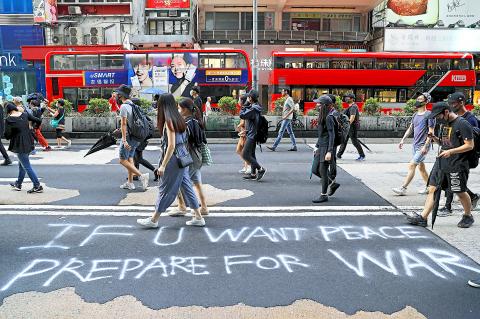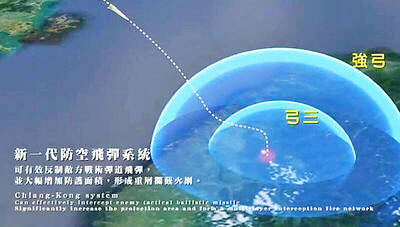Molotov cocktails were yesterday thrown inside a Hong Kong metro station, but no one was injured, the government said, as pro-democracy protesters again took to the streets angry at what they believe is Beijing’s tightening grip on the territory.
The Kowloon Tong station was seriously damaged in the attack, the Hong Kong government said in a statement.
Hundreds of protesters, many young and wearing masks, were marching in Kowloon at the time and were headed to a district near the Kowloon Tong station.

Photo: AP
About a dozen riot police took to the streets in Kowloon’s Tsim Sha Tsui district, normally a haven for local and international shoppers, behind the marchers shortly after news of the Molotov attack.
Hong Kong’s metro has borne the brunt of protests, with stations torched and trashed, and only returned to normal operations on Friday after being completely shut down.
The metro normally carries about 5 million people a day.
Hong Kong’s protests started in opposition to a now-abandoned extradition bill, but have mushroomed in four months into a pro-democracy movement and an outlet for anger at social inequality in the territory.
The protests have plunged the territory into its worst crisis since the UK handed it back to China in 1997 and is the biggest popular challenge to Chinese President Xi Jinping (習近平) since he came to power in 2012.
Hong Kong had experienced relative calm since last weekend, when a peaceful march by tens of thousands spiraled into a night of running battles between protesters and police.
Since then there had only been small nightly protests and advocates had not flagged any major action this weekend.
A small group calling itself the “Silver-Haired Marchers” yesterday began a 48-hour sit-in at police headquarters, describing themselves as “old, but not obsolete.”
“Whilst we may not be able to fight alongside the young protesters in the front line against an unjust government, escalating police violence and indiscriminate arrests, we take it to heart to uphold the core values of Hong Kong and defend the future of our younger generations,” it said in a statement.
Colonial-era emergency laws were introduced a week ago banning masks at public rallies, sparking some of the worst violence since the protests started. Protesters use masks to shield their identities.
However, hundreds of people, including schoolchildren and office workers, have since defied the ban and wore masks.
A group of protesters planned a “mask party” yesterday night.
Hong Kong police, once praised as “Asia’s finest,” are also facing a crisis of confidence amid the worsening political tensions.
Protesters accuse them of using excessive force, a charge police deny, and two protesters have been shot and wounded during skirmishes with police.

LIMITS: While China increases military pressure on Taiwan and expands its use of cognitive warfare, it is unwilling to target tech supply chains, the report said US and Taiwan military officials have warned that the Chinese People’s Liberation Army (PLA) could implement a blockade within “a matter of hours” and need only “minimal conversion time” prior to an attack on Taiwan, a report released on Tuesday by the US Senate’s China Economic and Security Review Commission said. “While there is no indication that China is planning an imminent attack, the United States and its allies and partners can no longer assume that a Taiwan contingency is a distant possibility for which they would have ample time to prepare,” it said. The commission made the comments in its annual

DETERMINATION: Beijing’s actions toward Tokyo have drawn international attention, but would likely bolster regional coordination and defense networks, the report said Japanese Prime Minister Sanae Takaichi’s administration is likely to prioritize security reforms and deterrence in the face of recent “hybrid” threats from China, the National Security Bureau (NSB) said. The bureau made the assessment in a written report to the Legislative Yuan ahead of an oral report and questions-and-answers session at the legislature’s Foreign Affairs and National Defense Committee tomorrow. The key points of Japan’s security reforms would be to reinforce security cooperation with the US, including enhancing defense deployment in the first island chain, pushing forward the integrated command and operations of the Japan Self-Defense Forces and US Forces Japan, as

IN THE NATIONAL INTEREST: Deputy Minister of Foreign Affairs Francois Wu said the strengthening of military facilities would help to maintain security in the Taiwan Strait Japanese Minister of Defense Shinjiro Koizumi, visiting a military base close to Taiwan, said plans to deploy missiles to the post would move forward as tensions smolder between Tokyo and Beijing. “The deployment can help lower the chance of an armed attack on our country,” Koizumi told reporters on Sunday as he wrapped up his first trip to the base on the southern Japanese island of Yonaguni. “The view that it will heighten regional tensions is not accurate.” Former Japanese minister of defense Gen Nakatani in January said that Tokyo wanted to base Type 03 Chu-SAM missiles on Yonaguni, but little progress

INTERCEPTION: The 30km test ceiling shows that the CSIST is capable of producing missiles that could stop inbound missiles as they re-enter the atmosphere Recent missile tests by the Chungshan Institute of Science and Technology (CSIST) show that Taiwan’s missiles are capable of intercepting ballistic missiles as they re-enter the atmosphere and pose a significant deterrent to Chinese missile threats, former Hsiung Feng III missile development project chief engineer Chang Cheng (張誠) said yesterday. The military-affiliated institute has been conducting missile tests, believed to be related to Project Chiang Kung (強弓) at Pingtung County’s Jiupeng Military Base, with many tests deviating from past practices of setting restriction zones at “unlimited” and instead clearly stating a 30.48km range, Chang said. “Unlimited” restrictions zones for missile tests is